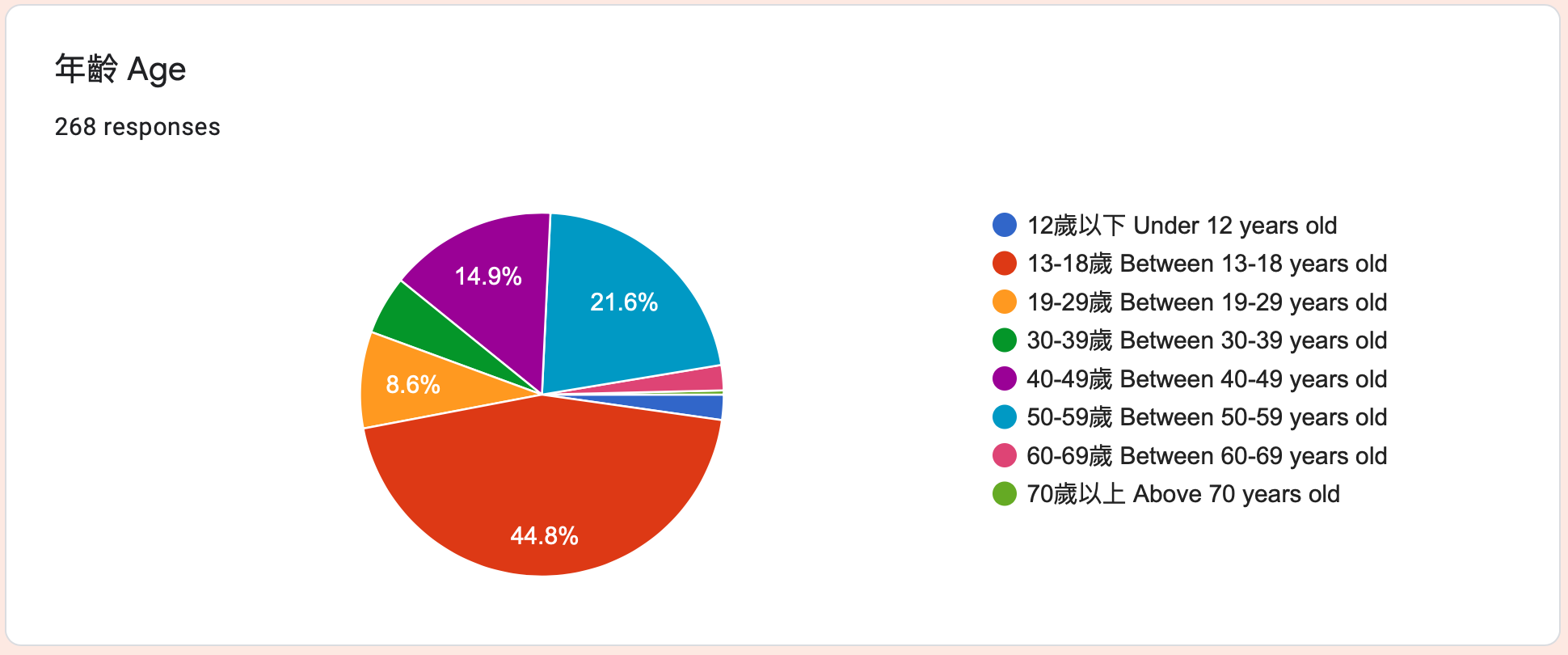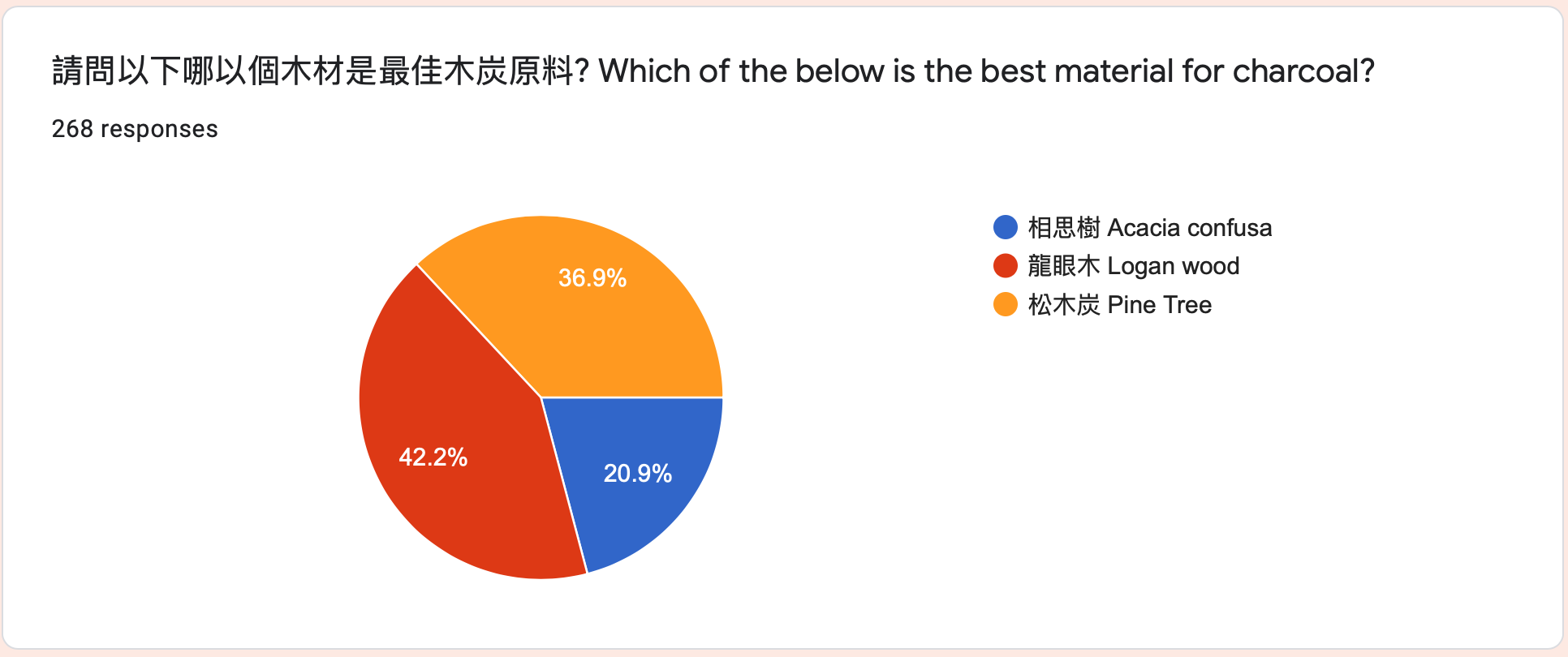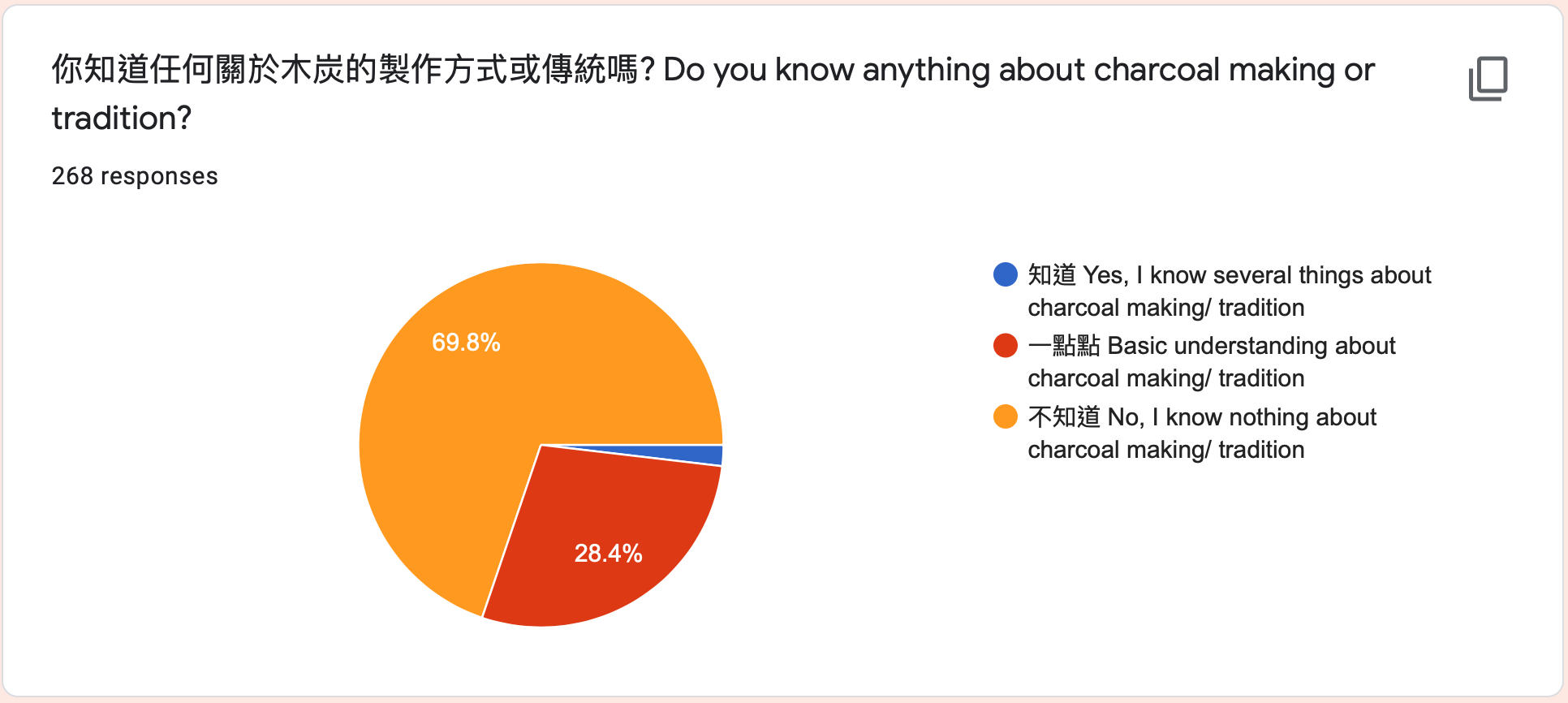Survey Response





From the graph above, about 98 percent of respondents believe that charcoal is used in BBQ. The second-highest ranking application is industrial purposes, which relates to the burning of charcoal for energy; about 68 percent of respondents know the fact charcoal can also be used in air purification and artwork. In addition, there are various individual responses suggesting charcoal can be used in suicide, construction, religion and more. The graph demonstrates the fact charcoal has gradually left our lives and turners into an abstract material used in traditions.

The graph above shows the percentage of our respondents seeing charcoal being used in a specific situation. The most common usages are BBQ and the Chinese Moon Festival, which is related to BBQ tradition. About 50 percent of respondents see charcoal in daily life objects such as air purifiers and artworks. The responses indicate how common charcoal will appear as a particular way in Taiwan. Therefore, the data matches what we expect as the respondents are more likely to select categories that are common or well known in Taiwan culture.

More than half of the respondents see charcoal once a year, which is definitely the famous BBQ in Chinese Moon Festival culture. As this percentage drops steadily until “more than once a day”, we can conclude that there are fewer people getting involved in charcoal-related activities on a regular basis. This shows charcoal is gradually disappearing in our daily life; it has been forgotten by most of us.

In fact, charcoal and coal released about the same (or slightly less) amount of emissions if charcoal is dried. In Taiwan, 46.11% of the energy comes from burning coal, which is almost half of all the energy Taiwan needs. Among other sources such as natural gas, nuclear energy, and sustainable energy, coal produces the most emissions and yet is the most common source in Taiwan. You may wonder why can’t we simply replace coal with charcoal, but there isn’t enough wood that can be produced into charcoal for biomass fuel.
Of all the respondents, 33.2% of the people have stereotypes against charcoal. Only 2.3% percent believe charcoal is worse than coal for the environment. In addition, more than one-third of our respondents have no clue regarding the emissions from charcoal and coal. Less than one-third of our respondents got the correct answer. The result indicates most people have misconceptions about charcoal.

According to Mr. Lee, the correct answer is Acacia Confusa, but it has the least percentage in the graph. Since Acacia Confusa is rare, many of our respondents could not know such a tree. Meanwhile, Logan wood and Pine tree are more common tree types in Taiwan. The results above justify how respondents tend to select the more common tree type when they have no clue of the right answer.


According to the graph of how much do the people who filled in this form understand about charcoal, we can know that most of the people are unfamiliar to what exactly charcoal is. From the scale of 1 to 5, the scale 2 has the most percentage with 43.7%, which these people might know some about charcoal, for an example, they know that during BBQ, charcoal is used. However, fewer people know about charcoal, most of the people layout in the scale of 1 to 3, which they don’t know much about charcoal, the taiwanese are being strange to one of the main industries in the past culture.

From the graph, there are fewer people who want to learn more about charcoal. There can be many reasons, maybe because charcoal seems to be not related to our life in latter-day, maybe the charcoal industry isn’t the main industry that is needed in modern, and also it’s not like a new thing for them, it’s like an antique for them that doesn’t get their attention. Even though charcoal isn’t important for these people, they still need to know how charcoal brings up the economy of Taiwan, then they will realize how important the “antique” is.

From the graph, most of the people think it is important to pass down charcoal, having more proportion against the people who don’t think charcoal should be passed down. Charcoal isn’t ready-made, the process of making charcoal is more complex than people can think of. First, the former of charcoal is Acacia Confusa, Acacia Confusa is big and thick, it takes a lot of hard work and time to cut it down, and it’s only the first process. The production of charcoal does not directly use fire to grill acacia wood,first by heating the earth kiln to force out the moisture contained in the wood block and enter the processes of dehydration and charring; then the grilling fire will continue day and night, lasting around two to one week, in addition, the temperature should be maintained between 350 degrees Celsius and 1,050 degrees Celsius. The skill and knowledge of making charcoal is breathtaking and amazing, also charcoal can be used in many ways around us, which people need to understand the necessity of passing down the charcoal.



From the graph, we can conclude the majority of respondents view charcoal as part of Chinese culture. For example, 66% of the respondents believe charcoal should be kept as a cultural heritage, while 37.3% of our respondents insist on tradition. In addition, we notice more than half of the respondents are looking for creative ways to develop charcoal. This indicates the future for charcoal, as the creative development of charcoal surely can attract more people. If charcoal can be combined with other products, the awareness of charcoal could be raised.

Regarding the preservation of charcoal, our respondents’ answers vary. The most popular option is school education. This would make sense because 127 of 168 respondents are students. Furthermore, the result also indicates students’ willingness to participate in the preservation of charcoal. Preserving charcoal through art and performance or labeling charcoal-related products are popular among respondents. To conclude the graph, we can see how the popular options in the survey have one similarity-to educate the society with charcoal-related information. The results help us to identify a way to spread the knowledge of charcoal, which will create a significant impact.


Conclusion
To conclude the survey, the majority of respondents agree to continue the traditions of charcoal. Only 7.5 percent of the respondents disagree to pass down the traditions of charcoal. Furthermore, we realized those who disagree to pass down the tradition are mostly students in the Z generation. This is caused by the lack of connection between the teenagers and charcoal. As other materials began to replace charcoal, teenagers barely had a chance to get involved with charcoal-related activities nor understand more about the tradition of charcoal. In this competitive society, people are willing to preserve the tradition of charcoal as part of ancient Chinese culture, but the willingness to participate of the percentage who are interested by the topic decreases because the charcoal industry is not making any profit.
Most respondents in this survey know basic information regarding charcoal. This indicates that charcoal is leaving our daily life and eventually turning into a tradition that only appears on special holidays. Fortunately, most people accept to learn more about the charcoal industry and view the industry as an important culture in Taiwan. However, when they were asked about their interest to take part in the inheriting process, there is an obvious shift of data as results formed a normal distribution.
It is clear that charcoal has become an ancient heritage. 66% of respondents believe that it should be preserved as part of Chinese culture, 37.3% want the charcoal to be a tradition. Our respondents are also looking forward for creative applications of charcoal, which could be an alternative development for the long-forgotten charcoal industry.